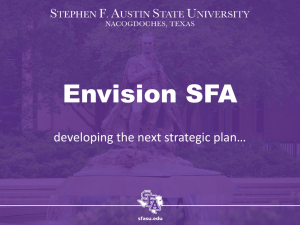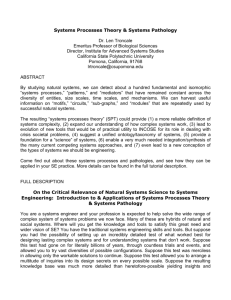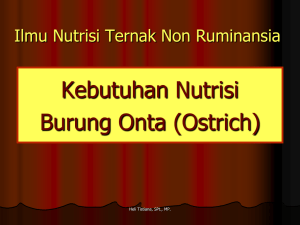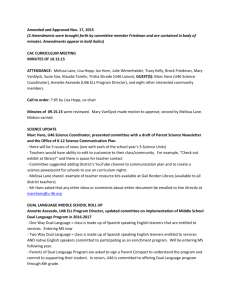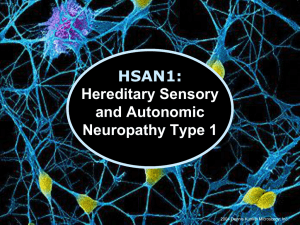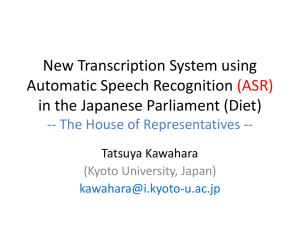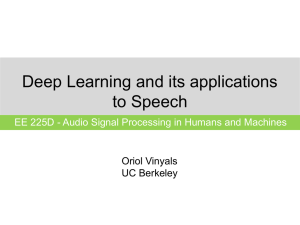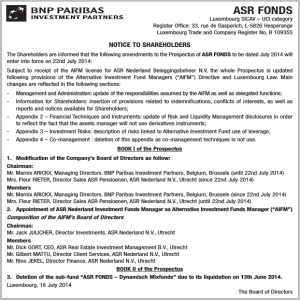Manuscript Instructions/Template
advertisement
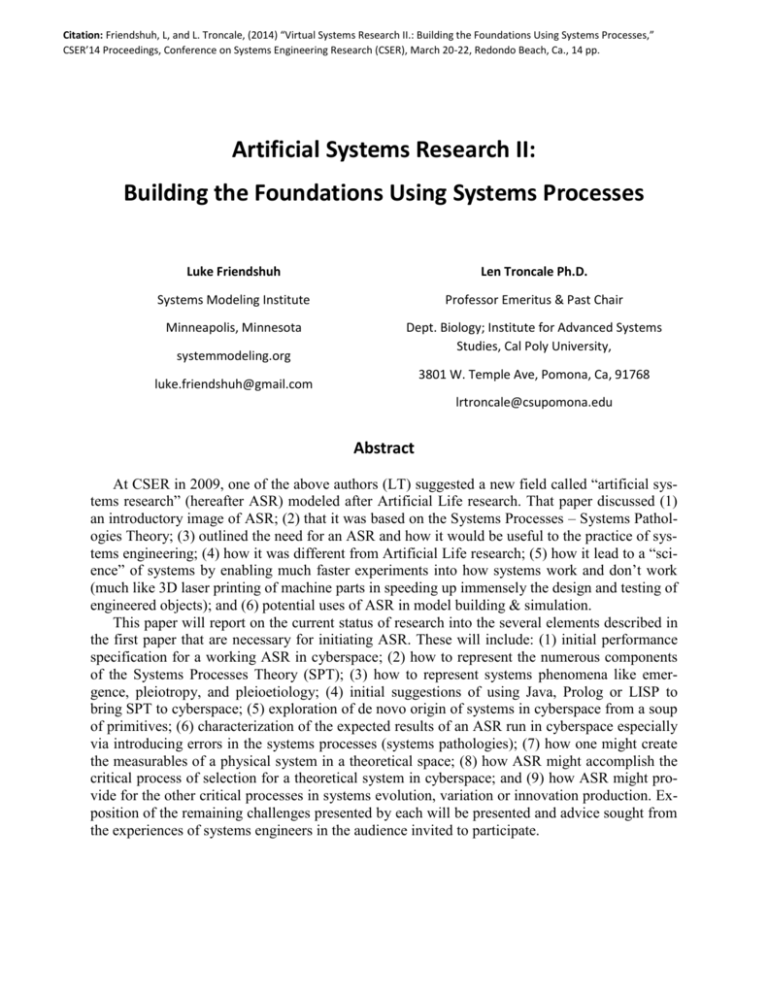
Citation: Friendshuh, L, and L. Troncale, (2014) “Virtual Systems Research II.: Building the Foundations Using Systems Processes,” CSER’14 Proceedings, Conference on Systems Engineering Research (CSER), March 20-22, Redondo Beach, Ca., 14 pp. Artificial Systems Research II: Building the Foundations Using Systems Processes Luke Friendshuh Len Troncale Ph.D. Systems Modeling Institute Professor Emeritus & Past Chair Minneapolis, Minnesota Dept. Biology; Institute for Advanced Systems Studies, Cal Poly University, systemmodeling.org 3801 W. Temple Ave, Pomona, Ca, 91768 luke.friendshuh@gmail.com lrtroncale@csupomona.edu Abstract At CSER in 2009, one of the above authors (LT) suggested a new field called “artificial systems research” (hereafter ASR) modeled after Artificial Life research. That paper discussed (1) an introductory image of ASR; (2) that it was based on the Systems Processes – Systems Pathologies Theory; (3) outlined the need for an ASR and how it would be useful to the practice of systems engineering; (4) how it was different from Artificial Life research; (5) how it lead to a “science” of systems by enabling much faster experiments into how systems work and don’t work (much like 3D laser printing of machine parts in speeding up immensely the design and testing of engineered objects); and (6) potential uses of ASR in model building & simulation. This paper will report on the current status of research into the several elements described in the first paper that are necessary for initiating ASR. These will include: (1) initial performance specification for a working ASR in cyberspace; (2) how to represent the numerous components of the Systems Processes Theory (SPT); (3) how to represent systems phenomena like emergence, pleiotropy, and pleioetiology; (4) initial suggestions of using Java, Prolog or LISP to bring SPT to cyberspace; (5) exploration of de novo origin of systems in cyberspace from a soup of primitives; (6) characterization of the expected results of an ASR run in cyberspace especially via introducing errors in the systems processes (systems pathologies); (7) how one might create the measurables of a physical system in a theoretical space; (8) how ASR might accomplish the critical process of selection for a theoretical system in cyberspace; and (9) how ASR might provide for the other critical processes in systems evolution, variation or innovation production. Exposition of the remaining challenges presented by each will be presented and advice sought from the experiences of systems engineers in the audience invited to participate. 1.0 Statement of the Problem Historically, general theorists of systems investigated only a very small number of the isomorphies that they hypothesized existed from their early comparisons of particular systems. They did not attempt to prove their isomorphic status so much as assume their existence. Further, the key feature of interactions between those isomorphies, critical to explaining systems dynamics in general, were not attempted [ref]. 1.1 What Is Chronically Missing in GTS’s Needed for SE: For systems engineering to be able to use systems science with confidence in its work, these four missing elements are critically needed: (i) enabling detail, (ii) sufficient principles (isomorphies, in the SPT, “processes”), (iii) existing evidence, and (iv) ability to test. We suggest SPT when put in cyberspace as ASR would be a robust beginning to fill these needs. The lack of detail on how systems work in soft systems methodology (SSM) popular with SE practitioners and the lack of evidence for principles of systems are the opposite of what is needed for SE. Clearly SSM and systems thinking helps human organizations approach the systems nature of many problems. Agile and Lean approaches help human organizations more efficiently produce products. But they do not specify much that is substantial, if anything, about how a systems should work when it is produced [Troncale, 2014]. They do not prescribe how systems achieve sustainability in nature. What SE might benefit from, now that we are all becoming more aware of systemness in general, is a very detailed, evidence-based image of how successful systems originated and fulfil a wide range of functions. The Systems Processes Theory (SPT) describes as many as 50 isomorphies that can be proven to exist across a multitude of natural systems [ref]. It also describes hundreds of specific mutual impacts these systems processes have on each other as a network of systems dynamics [ref]. The specification of this dynamic in the SPT and the evidence behind it from experiments in the natural sciences provide an opportunity to model a “sufficing” system and place that model in cyberspace for testing. 1.2. Vision: Experiments in General Systems Science in Cyberspace: However, the SPT by itself provides only a specification of systems-past. We also need the ability to manipulate the numerous systems processes and their interactions to better test and extend the validity of our descriptions of precisely how the systems processes work and how they interact. We need to test alternative systems architectures to see if we can design improved systems-future. If we could put the SPT into cyberspace, we would be able to alter the overall net of interactions much like controlled experiments in molecular biology alter the very complex network of cell metabolism to find out what this effects what with what consequences. We could remove a single SP and see how that affects cyberspace measures of overall systems efficiency or sustainability. We could remove a single linkage proposition (influence between SP’s) and find out its system-wide effects. We could alter “motifs” and “circuits” within the network to find out how these alternative affect outcomes. These would constitute the first time ever possibility of actually testing and not just talking about general systems models. 1.3 Usual Components of a Computer Model Simulation: A computer model captures and emulates key behaviours of what you want to model and then the model is used to simulate those behaviours over a period of “modelled” time (independent of real time) with a variety of possible input parameters. The simulation gives output data of interest about the system modeled. The key piece for our purposes is the ability to run an abstract version of a system by representing system processes in a synthetic world created by the computer model simulation. Some of the key com- ponents of any simulation are usually: (i) the entities you want to represent; (ii) the events you want to represent; (iii) the rules for the interaction of the entities; (iv) the initial values that characterize the entities and interactions; (v) the limits of computer and time resources over which the entities and interactions are allowed to run. In our case, (i) would be the SP’s of the SPT (see Section 2.3); (iii) would be the LPs of the SPT (see Section 2.4); and (iii) would be markers for some the SP’s because some would constitute events and arise spontaneously (section 2.3). We need to continue research on how to represent (iv). The whole purpose of the ASR is to use many different initial arrangements and values for all, but especially (v). We are assuming that any particular “run” would be able to progress through millions of cycles of computer time in very reasonable spans of human time (hours, days) such that we could simulate billions of years of trials and events. We also assume that we will be using some measures of hardware resources to get at the minimization and maximization functions we describe in Section 4.1 & 4.2. 1.4 Intriguing Obstacles to Making A General Theory of Systems Executable: We expect that the main obstacle to this vision is how to represent the “general” principles and processes instead of particular processes. Models of the past in natural systems [e.g. Odum] represent mechanisms that involve real entities. Those workers have many measures in space, mass, time, energy, size, frequency, etc. for these particulars that they can program into cyberspace. Even models of biological social systems, such as those for ants or humans in agent-based modelling, have features and qualities that can be programmed in. If one intends to place a general system in cyberspace, what measures do you use to specify “abstract” mechanisms and architectures? Does this difference in what is represented preclude making the model executable? 2.0 GTS Simulations Based on a Unified Systems Processes Theory (SPT) What is SPT and how can it effect modelling, simulation (MBSE) and enable a better science of systems? More to the point, how can SPT become the substantial knowledge base and guide for establishing the new field of Artificial Systems Research to emulate Artificial Life Research. 2.1 Ongoing Projects of the INCOSE SSWG & ISSS-SIGs: A decade ago, the Int’l Society for the Systems Sciences established two new Special Integration Groups (SIG’s), founded and originally chaired by one of this articles authors (LT), whose mission it was to: (i) sponsor research leading to a better general theory of sytems; and (ii) discover “diseases” or dysfunctions in systems in general leading to a new field we called Systems Pathology. In 2010, INCOSE signed a Memo of Understanding with ISSS to cooperate in improving systems awareness. At present there are no less than 4 Working Groups of INCOSE focused on this goal: (i) the Complex Systems Working Group (CxSWG); (ii) the Systems Science Working Group (SSWG); (iii) the System of Systems Working Group (SoSWG); and (iv) the Natural Systems Working Group (NSWG). Around 2009, the SSWG initiated two (of now 10) special projects. The goal of the first project was to unify, integrate, or synthesize the numerous sources of systems knowledge. The goal of the second was to establish a systems-architecture-based Systems Pathology (understanding of generic ways systems dysfunction). Since then, multiple workshops and paper sessions at annual conferences have been attended by workers from both INCOSE and ISSS to contribute more than 50 products to-date advancing these two projects. 2.2 Why Focus on Systems Processes?: The major framework explored in the ongoing work of both projects is focusing on systems processes -- how they explain how systems work in great detail and provide a rationale for explaining how systems don’t work, or pathologies of systems. Other papers and reports [refs] give the arguments why experiments elucidating “process- es” have proven so successful in the natural sciences over the last 300 years. These papers also envisage that identification and proof of the isomorphy of “systems processes” will likewise prove to be a useful approach for discovering an evidence-based general theory of systems. It is a happy coincidence that the focus of these projects on processes also 2.3 Introducing A Comprehensive List of Systems Processes: In work to date [ref], we use 45 candidate systems processes as shown in Table One. This listing is in the order of our estimation of the community awareness and evidence for each candidate systems process going from “most” to “least” known. We started with a list of 110 candidates but combined or collapsed some into one as merely “discinyms” of each other, and eliminated others as “identifying features” of a master systems process [Friendshuh & Troncale, 2012). Still others we eliminated until further research could be completed. So we expect this list will actually expand rather than shorten in the future. It is our current working list. Do you recognize all of them? Are there any key systems processes you think are left out? Please contact us and suggest others. 1. Feedback, Several Types of 22. Variation Processes 2. Cycles/Oscillations/Hypercycles 23. Competitive Processes 3. Network Structure & Processes 24. Adaptation Processes 4. Hierarchies & Clustering as a Process 25. Evolutionary Processes 5. Flow Processes (includes I/O) 26. Field Processes & Potentials 6. Equilibrium & Steady State Proc’s 27. Allometry, Systems-Level 7. States, Transitions (Phases) 28. Exaptation, Cooption Processes 8. Boundary-Forming Processes 29. Growth Patterns & Laws 9. Chaos & Chaotic Processes 30. Development Patterns & Laws 10. Fractal-Forming Processes 31. Integration Processes 11. Binding Processes/Interactions 32. Dysergy as a Process 12. SelfOrganiztion/Autopoiesis 33. Decay, Autolytic & Senescent Proc’s 13. Symmetry-Forming Processes 34. Amplifiers as a Process 14. Synergy/Synchrony/Cooperation 35. Limits, Physical & General 15. Non-Equilibrium Thermodyn-Irrever 36. Power Laws, Cross-Disciplinary 16. Duaity/Complementarity Processes 37. Functions-Forming Processes 17. Origins Processes 38. Broken Symmetry as a Process 18. Emergence Processes 39. Quantum Processes 19. Self-Criticality/Catastrophes as a P 40. Allopoiesis Processes 20. Information-Based Processes 41. Minimization Principles 21. Replication Processes 42. Maximality Principles 43. Constraint Fields & Analysis 44. Neutralization Processes ??? 45. Metacrescence as a Process 2.4 Linkage Propositions are the Rules of Interaction Between Processes – Systems Dynamics: LPs are statements in any language (in our work usually English-American) of how one systems process influences or impacts another. So in general, an LP has the form ……. SP1 (operator, relation, or influence) SP2 …….all stated in words. Usually an LP is a stand-alone statement, so a duality, supported by either much of the systems literature we are trying to unify, or by empirical published research in the sciences. LPs capture what has been learned from not only systems thinking and philosophy all the way to the natural systems sciences. They state them in discrete units easy to manipulate, cite references for, test, teach, and assemble into larger circuits or motifs. Modern texts in cell and molecular biology have a very detailed set of experimental findings to communicate and use to suggest new hypotheses to test. The most extensive and popular modern texts [refs] now organize this massive set of data into short unit statements consistent with the consensus of experts and clustered by major cell function. In as sense, this is what SP’s and LPs do for the emerging science of systems. Note the very important addition that this integration will enhance our ability to not only attain a deeper, richer understanding of systems dynamics but will also enhance our ability to conceive of and formulate new answerable questions that would not have been possible without this framework. 2.5 Maps of Interactions of Systems Processes: The most exciting aspect of Systems Processes Theory appears when you map the entire set of SP’s and LPs together as shown partially in Figure One below. systems processes are represented by the nodes. LPs are represented by the lines. The SP’s are actually clustered into several super functions of systems in general. If a systems process is tightly connected to one of the larger spheres (major system functions), it is because it contributes to attainment of that function. LPs could also be clustered or shown as different types of lines (solid, dashed, dotted, etc.) but are not here because this is a simplification. But even at this level of resolution, perhaps it is clear how detailed a picture of systems dynamics is possible using the SPT. This paper is describing how the entire SPT network could be put into cyberspace to allow its further testing and manipulation. 3.0 Initial Performance Specifications for Artificial Systems Research Clearly it is way too early to compose a definitive list of performance specifications. We suggest some here so they can serve as placeholders and reminders to increase the detail of the list as we carry out early attempts at implementation. We realize that there are lists of “essential” performance specifications and lists of “wished for” specifications. Here is a starting list of both joined together, not in priority order, yet. (1) can represent all SP’s; (2) can represent all LP’s; (3) can generate data graphs comparing efficiency of min-max across run cycles for any specified sequence or time period; (4) can assess computer hardware use of resources each run cycle; (5) operates cross-platform?; (6) has a automatically updated CGI/GUI that allows easy addition or subtraction of any one SP or LP; (7) Can you think of any others? 4.0 What Is Exchanged in ASR? How Is Influence, Changed Measured in ASR? As described in a previous section, we expect the major obstacle to ASR is solving the problem of representing “general” “abstract” mechanisms in cyberspace instead of the usual “particular” mechanisms typical of cyberspace executable models. Many models are diagrammed for better communication as nodes and links in a network (as shown above for the SPT). The obstacle we address here comes down to what “flows” through or along the links that connect the nodes for the SPT in the ASR? Often these links or flows are the ways that entities interact in the real cases of that which is modelled in cyberspace. It is how the entities influence each other. In the best cases we have hard data on the magnitudes of these flows. Calculations or consequences of these influences are what constitutes the dynamics of the systems modelled. It is this dynamic behaviour and the quantities involved at each stage of the changes in behaviour that we can then compare with the behaviour of the real system in nature and the quantities known for those actual instantiations. These comparisons enable judgement of the validity of the model and its prospective use in prediction. We need this for the ASR if we are to compare different configurations of general systems architectures. 4.1 Using the Systems Process of Minimization: We hypothesize that the most critically important optimization true of virtually all natural systems is their achievement of sustainability through minimal use of ALL the factors needed, simultaneously. Thus each systems process is an architectural arrangement that achieves needed function for the system in context requiring the least magnitude of variables in our space time configuration. We use the following cartoons to communicate this idea. Figure Two shows that any one node in Figure One is the least expensive of alternatives in a given (all factor) landscape. Figure Three shows that any Linkage Proposition, line (connection) in Figure One is also the minimum required factors to achieve system function in a given (all factor) context. Many as yet immature systems start with various architectures, but many also don’t survive or achieve sustainability. It is only those systems that have the greatest minimization of the most systems processes and their linkages that continue long enough for humans to perceive them. We think our justification for this working assumption is very powerful. The SP’s and LP’s can be proven isomorphic because they are found in many natural systems when they are compared at the sufficiently abstracted, systems process level. These suppositions are supported by peer-reviewed, published, citable experiments in the natural sciences. 4.2 An Initial Catalogue of Minimizations: What is minimized in real (manifest, natural) systems that we know from experiments across all the sciences? Our current study list includes: (i) energy; (ii) space; (iii) number of required events; (iv) mass; (v) information (on scales to which that applies, but we define information broadly to even the atomic and black hole levels); (vi) dimension; and, of course, (vii) time. It is important to note that we are seeking global minimization; all of these factors at the same time. We call this simultaneaty. The surface that serves as the landscape for Figures Two and Three above are the global factors taken as a whole; the depressions that candidate SP’s and LPs fall into (evolve into)(are selected into) are the minimizations of these global factors. They are the one’s that survive long enough for human perception to note their existence. Can you suggest any other minimizations? 4.3 Representing Minimization in Cyberspace: So the critical question is how could one represent these factors in cyberspace in order to measure them for the various experimental manipulations of the full SPT model. One of the main functions of SP’s is to allow systems to make efficient uses of resources. For example, using less energy allows the system to be stable for longer periods of time on a fixed amount of available energy. Minimization/optimization can be measured directly in the modeled system or it can be an outcome of limited resources and length of survival of the system. One could measure any alternative models efficiency in terms of raw machine resource usage. 4.4 Must Not Ignore Complementary Systems Process of Maximization: It is not only minimization that is sought, but simultaneously maximization. What is maximized that can be measured? We are exploring such measures as: (i) stability over time (transtemporal stability); (ii) temporary stable states (phases); (iii) emergence of new qualities; (iv) emergence of new scales of entitation; (v) “colonization” of new contexts. All of these would be outcomes evident in the status of the entities and be measured less in terms of use of raw machine resources. Are there any others you could think of? 5.0 Exploring Alternative Strategies for ASR Implementation Since Artificial Systems Research is a wide-open, novel idea, we prefer to explore several different strategies for its implementation. It is too early to be able to distinguish between the effectiveness of various approaches we can think of to try. Here are seven different contenders for the strategy or tool to implement ASR or the SPT model in cyberspace. 5.1 Exploration of object-oriented programming/modelling approach: One way to represent the usual components in a computer simulation is by representing them as objects. This is a common programming paradigm supported by many different computer languages such as Java, Python and C++. In this approach, the SP’s would be object classes with their features and functions implemented within the class methods. The SP’s would interact with key environmental features of the synthetic world that would also be represented by object classes. 5.1.1 The Virtual Environment: The virtual environment would have fundamental abstract forms of Energy/Mass, Information/Entropy, Force/Fields and Space/Time represented in a way that the SP’s objects can interact with them. The modelling challenge will be to have a high enough level of abstraction to keep the model relatively simple, yet have enough details to keep it useful. 5.1.2 SP’s (Chart One) as an Object Class: SP’s would be object classes that can interact with the virtual environment. The SP’s could obtain energy, output energy, store energy, obtain information, output information, store information, and maintain physical structure. They would also be able to interact with each other and be linked through LP’s to perform key system functions together. The SP objects could be represented as different icon types in a graphical user interface (GUI). Different model views could show their connections to each other and the environment. For example, one view could show energy flow, another information flow and another certain types of LP.s Opening up a SP icon could allow access to typical modelling parameters for that particular SP. Internal method access could also be allowed for customization of the SP’s behaviour in particular instances. 5.2 Exploration of De-Novo or Virtual Origins of Systems: There is a vast literature in the conventional sciences on “origins of natural systems across all scales – from cosmological, astronomical, geological, chemical, biological to social systems [ref]. Nobel laureates have been awarded for research on origins, specifically the original abiotic origins of biochemicals demonstrated in the Miller-Urey experiments [ref] or the background radiation patterns of the early universe discovered by Penzias & Wilson [ref]. It is common to find scientific articles reporting research on origins in widely read interdisciplinary journals like Science and Nature (e.g. on origins of planetary systems [ref]). The SPT regards all of these as “manifest” systems – real material systems of particulars that have and continue to be sustainable. Stars were born 14 billion years ago and continue to be born today. But notice that SPT compares these manifest systems to derive the abstracted processes by which they operate which are quite distinct from the particular mechanisms by which they operate. The form of the process cycles is not as particular as the biochemicals that represent different proven steps in the Krebs Cycle. Nor do these particulars match the steps in the sunspot cycle. Still all 52 such natural systems examples [ref] to date have the abstracted steps that represent cycles as a general systems process. It is these abstracted mechanisms that we want to put into cyberspace. In the SPT, several systems processes have partial influences on origins. These dynamics may help explain origins of particular systems, and even lead to a theory of the mechanics of a new general theory of emergence as one of the authors has proposed [ref]. But no work, even in the SPT, exists on the origins of abstract universal processes. One of the intriguing possibilities of the ASR Project would be priming virtual computer space for the “spontaneous” origin of the systems processes. This would emulate the “origins of life” experiments, or artificial life runs that demonstrate the appearance of new “species” or agent-based simulations that show the appearance of new behaviors. How could ASR based on SPT elucidate emergence of the systems processes de novo (from the new), in an aparticular vs. abiotic manner? 5.2.1 The Virtual Environment: A virtual environment very similar to what was mentioned in section 5.1.1 would have to be developed. However, in this case, the environment would not have any existing SP’s in it. 5.2.2 How to explore virtual design space: Even though we can envision a virtual computer world that a system can exist in, developing a way for a system to emerge from this environment is problematic. There has to be a way to explore what is possible within the environment. The challenge is interesting because is forces us to ask the same fundamental questions we ask of the universe itself – how did it all come to be out of “nothing”? 5.2.3 Potential Starting Points: One way to solve the “how do you start” problem is to create different “system” starting points. You could set up the raw environment to represent different conditions at various times in the history of system development. For example, you could start with the inflation period after the big bang where the fundamental building blocks of matter were formed; or at star formation; or life formation on earth. One could even explore what environmental conditions allow system formation. Still, how a virtual system would form in this type of virtual environment with current computer languages and architectures is a challenging question to answer. 5.3 Evaluation of AI-Associated Languages (Prolog; LISP): Both of these languages contributed to early efforts in artificial intelligence. Prolog is a logic-based programming language. It is comprised of declarative statements of relation that are regarded as rules. These facts of relation or rules allow computational queries or requests. The computer follows the myriad of possibilities that are in cyberspace if given a sufficiently large set of statements. LISP is one of the oldest computer languages. It is a “list” processing language (thus the name). Interlocked lists are its main data structure. Well the Linkage Propositions connect the lists of systems processes and so it would seem that SPT is well suited to representation in LISP. One of our objectives is to encode all 200 current Linkage Propositions in an appropriate computer language. For example, the English semantic nature of the Linkage Propositions enables their direct translation into Prolog. For example, one could encode the LP Association Classes as ……… • (is-a-type-of _____ _____) /or/ (inhibits _____ _____) /or/ (is-a-partial-cause-of _____ _____) /or/ (is-a-partial-result of _______ _______) ……. where the underlines are the two systems processes involved. Here are 13 recently formulated Linkage Propositions from 5 different natural sciences expressed as Prolog statements [McNamara & Troncale, 2012). Each of these candidate Linkage Propositions is supported by experimental evidence in a deep case study of a dozen completely different particular phenomena of astronomy, physics, biology, mathematics, and geology. (is-a-partial-cause-of symmetry fields) read as “symmetry is a partial cause of fields” (is-a-partial-cause-of coupled +/- feedbacks oscillations) (is-a-partial-cause-of phase/state hierarchy) (is-a-partial-cause-of feedback duality) (influences/increases fields flows) (inhibits negative feedback positive feedback) (is-a-partial-cause-of coupled feedback equifinality) (is-a-partial-cause-of coupled feedback phase/states) (is-a-key-type-of hierarchy networks) (are-a-partial-cause-of fields symmetry breaks) (is-a-partial-cause-of boundary conditions storage-info) (are-a-partial-cause-of symmetry breaks flows) (is-a-partial-cause-of binding/linkage fields) As such these statements could be put into computer cyberspace to work on each other. In the past a set of Prolog statements have been used in this way to generate new statements not yet discovered. Language has a set of rules encoding relationships and the logic in the sentence strings is manipulated and followed in every possible combination to generate more than is input. These new statements could then be tested for efficacy in sustaining general systemness using the other methods described. Prolog LPs could be used to simulate abstract representations of systems in a new way or to discover new network theorems, or even suggest new hypotheses for experiments in the natural sciences. The new LP in abstract systems theory would suggest interactions of particulars in real systems that reductionist research had not yet perceived. Prolog statements have been used in Artificial Life research to act as agents evolving still newer agents across relatively vast time periods while taking only hours of CPU computer time and resources. Four additional important features of Prolog is its popularity, familiarity, support of GUI’s (that will be much needed given the wealth of detail for SPT) (see SysInformatics, Troncale, 2014) and network applications (another major feature of SPT). 5.4 Evaluation of Agent-Based Modelling (ABM) Approaches: The appearance of agentbased modelling tools has stimulated numerous studies of everything from ant behavior to human economic behaviours. Agent-based modelling has been especially useful for simulations of very complex social systems that cannot be studied by the methodologies of the natural sciences. It has been particularly associated with demonstration of emergent behaviours. At first glance ABMs do not seem compatible at all with our SPT that is based on abstracted systems processes. One of us (LF) is skeptical that “processes” per se can be or should be represented as autonomous individuals. We normally represent agents that are objects with locations. Processes aren’t objects, nor do they have “location.” However, LT notes that each systems process is characterized by from 5 to 12 unique “identifying features” and often several unique “identifying functions. These could be entered as the usual “characteristics” or responsive behav- iours” of the individual agents (separate SPs). ABMs usually have numerous agents (SPT has many SPs). ABMs have decision-making heuristics (SPT has the LPs as heuristics). ABMs have an environment distinct from the agents (SPT in the virtual space of ASR would have the computer resources as the environment). ABMs have to program in rules for learning or adaptation while SPT has these mechanisms and more of like kind represented in some of the systems processes themselves (see Table One). Since there are several ABM toolkits, we could simply see if they would accept the type of specifications SPT would provide to test this approach. Another tool dimension of interest are the new development of ABM data parallel algorithms. These would be of interest to our attempts to model SPT simultaneity. The goal of ABMs is more to understand how a complex system arrives at its observed behaviour than to design better behaviours. Since our understanding of systems is so rudimentary, this would be helpful to the systems sciences. Presumably improved understanding would lead to better designs, probably not directly from the ABMs themselves, but from application of understanding by SEs and SSs trained in ASR. ABMs might help us appreciate use of “coming to equilibrium” as another mark of sustainability. One point of difference is that ABMs usually have a mechanism to introduce randomness while at first glance the SPT might seem to be quite determined. That is true only if you look at isolated LP’s or SP’s taken alone. When observed as a whole network, SPT embodies many, many different instances and types of non-linear causality [ref]. In fact we use SPT to study the nature of non-linear causality. That is why we use operators like “is a partial cause of” and “is a partial result of” in the LP’s. This gives SPT a decidedly non-deterministic nature. Natural systems, the origins of much of the SPT formulations, have both deterministic and non-deterministic elements. So the system of systems processes has inherent randomness. We are aware of the observation that agent based modelling has a non-trivial relation to object-based programming (Section 5.1). Perhaps this overlap can be explored or exploited. It is also interesting that ABMs exhibit power law distributions since this is one of the SPs. That ABMs reveal robustness of different configurations is exactly what we want to do and test with alternative systems architectures in ASR. ABMs also show self-organization, another SP. It is as if ABMs, already constructed for many domains, naturally come up with (spontaneously generate SPs similar to the ones we show as isomorphies by comparing many natural systems. Notice the relation of this to our discussion in Section 5.2. 5.5 Evaluation of Odum-Based Energy Circuit Flow Models: Howard Odum was awarded the Crafoord prize in Ecology in 1987 (the equivalent for that field of the Nobel Prize) for his work on modelling energy flows and their effects on ecosystems and economies [refs]. In his 1983 text titled Systems Ecology, Odum cites general systems principles in many sections. Unlike other supposed systems founders, he used not just one but rather many SPs in his work including flows, storage, hierarchical structure, cycling, oscillations, thermodynamics and more. Odum used elaborate energy circuit language diagrams, which he called “energese” mimicking the rigor of the circuit diagrams used in electrical engineering. Each transforming link in his diagrams were characterized by differential equations. We would like to test both his diagramming system (his books came with plastic templates to enable drawing the circuit diagrams with ease) and his use of mathematics for SPT because it uses even more SPs. One quote from the Wikipedia entry on Odum indicates its relevance to our attempt to establish an ASR. It states “Due to the focus on systems thinking, Odum's language appears to be similar in approach to the Systems Modeling Language recently developed by INCOSE, an international Systems Engineering body.” So either SysML or Odum energese would provide a good basis for starting an ASR. Note in proof: One of the subprojects of the SSWG SP/SP project, involving system engineers Bill Schindel, Gary Smith, and Tom Marzolf, is using a version of SysML to build an initial framework for modeling SPT. 5.6 Evaluation of Neural Net Representations As An Approach: Clearly the natural sciences have demonstrated that networks are everywhere [ref]. That is why we have included network-forming processes as one of the candidate SPs. It seems that discoveries about networks are everywhere in the popular and science press. But it is not only rigorous new fields like systems biology that are interested in network theory. The study of everything human from airports to literature to use of social media have been informed by network based analysis. As shown in Figure One, even the SP & LP complex is a network. Can we use advances in network theory to initiate the ASR built on the SPT network? One of the most advanced examples of a complex network is the human brain. Billions of interlocked neurons form nets in our brain with different nets having different functions. Yet the whole melds these independent nets into a net of nets. So past efforts at neural net simulations may help us formulate an ASR. There is a relatively new field called artificial neural nets. Artificial neural nets are models in the computer that simulate individual neurons of high connectivity. Each neuron can accept input from others and use those input values to transfer information to other neurons or other nets resulting in information flows across the nets. These flows can “learn” new connections or connect in new ways to recognize patterns or regularities. Some of these can recognize patterns in otherwise chaotic information such as recognizing patterns in stock market movements that even the best human experts cannot perceive. Artificial neural nets have successfully been used in attempts at voice recognition and vision by computers. Rule-based programs had mostly failed at this task. The SPT is both rule-based and interactive-based simultaneously. Neural net approaches might work for the latter, but not for the former features of the SPT. But there are other SPT features that may coincide with artificial neural nets (ANNs) approaches. ANNs exhibit machine learning. SPT does not learn so much as it adapts. Recall our hypothesis that the way SPs and LPs find their lowest resource state results from gradual selection of many alternative configurations attempted. That is why they appear to us as isomorphic after the fact. The systems architectures find the same general rules no matter what the particulars or start states. To us this is an analogue of machine learning; it is learning on another time scale. In ANNs, learning is a result of decreasing departure of the output from the “solution,” where the manner by which the output is made from the inputs is altered until that discrepancy is minimized. This is similar to the gradual approach of the SPs and LPs to the SPT state. Other features of ANNs (processing units, parallel, non-linear, adaptive, collective, simultaneous, distributed) are all also features of the SPT further encouraging us to explore this method. Perhaps one of the main differences is the widespread use of “weighting” in ANNs. At this time, SPT does not use weights but regards all SPs and LPs as equal. Perhaps study of ANNs will cause us to change this tenet. It is the weighting function that eventually leads to the learning of a pattern. This is not a AI ultimately rejected ANNs because (i) their neural nets were initially far too simple, (ii) the researchers were frustrated because they could not “trace” a causal sequence by which ANNs learned the pattern, and (iii) computer hardware made it difficult to emulate the massive parallel nature of the artificial neural nets. Perhaps using an ANN approach to SPT could ameliorate some of these problems. 5.7 Why Systems Dynamics Models Are Not Adequate: For many years interested workers from elementary school students to their teachers (see Creative Learning Exchange website) to university professors, university researchers, and professionals studying crisis social problems have been using Forrester’s Systems Dynamics out of MIT to model systems simple to complex. The great popularity of the Limits of Growth models of the seventies attracted many downstream studies, and also a great deal of funding. They were followed by many nations in Europe and the U.S. We will not be using Systems Dynamics tools because they tend to focus almost exclusively on feedback loops and their consequences. A glance at Table One would indicate that feedback is only one of some 50 candidate systems processes. So much emphasis on one process alone leaves too much out of the systems model to give confidence to its predictions. Indeed, the Limits of Growth predictions did not happen in the time scale estimated. Our colleague told us (personal communication) that once he compared a Systems Dynamics model of ecology and economics to one of his (that incorporates more, but still not all SP’s) and the SD model failed to make the predications the real systems exhibited. So we welcome others to try out SD or to expand SD explicitly with the many SP’s, but we have eliminated that alternative. Can you think of any other possible approaches?: Please contact the authors at their emails above or check into the several SPT websites to suggest other potential virtual world implementations of SPT. 6.0 Problems Expected for Placing Theoretical, Abstract Systems in Cyberspace Whichever strategy is selected, there are some especially difficult challenges to modelling a “general system” versus as “real system.” That is not to say that all the difficult challenges faced today by simulating real systems will not face mounting an ASR effort. ASR will still face those problems plus some of the following. 6.1 What is selected for or against?: This essentially means “more/many” “responses to a single stimulus.” It is used in genetics to indicate that a single genetic change has multiple effects. A common example is sickle cell anemia ALife entities adapt and evolve because selection is programmed into virtual space. ALife programs have generators of diversity coded in but the gradual evolution and adaptation of the entities would not proceed unless there was selection between the alternatives so generated. For Artificial Systems Research to work like Artificial Life simulations, we must ask “where is the selection function?” And if included as one of the general proeesses, what measures can it act on? 6.2 The Role of Mathematics: As mentioned for Odum circuit models above, and as typical of many of the best natural systems models like climate modelling, or weather simulation, often each and every linkage is moderated by a set of equations. Odum went so far as to say to one of the authors that no one could claim to do a systems model unless they were proficient in calculus and differential equations. Where is the place for math in SPT in or out of cyberspace? Several collaborators have suggested category theory as consistent with SPT and especially clustering of the SPs. We suggested in an earlier paper in the SPT series that the LPs could be formalized by some old, as well as some unique new mathematical operations. [ref]. One of us has the intuition that true general systems theories will require a new meta-language AND a new type of unification of four established mathematical domains, namely topology, number theory, probability, and category theory. Attempts at an ASR may clarify the role of mathematics for abstract entities. 6.3 Particular vs. Abstract: While there are numerous past attempts, a grand literature, funding and motivation to simulate a wide range of “particular,” “manifest,” or “real” systems, there is almost no experience in modelling completely abstract processes. The stovepipe mentality of the disciplines, libraries, university departments, corporate departments, and even publishers attach great value to modelling their particular scale of reality or phenomena. But the success of these stovepipes actually has inhibited cross-disciplinary abstractions like ASR. 6.4 Manifest vs. Possible: The distinction between “real” systems and abstract does not go far enough. There are also potential fields that would define possible systems we humans have never directly experienced. New specialties like branches of synthetic biology are devising ways to alter the “grammar” and the codes of the genome to make proteins not possible before. Theoretical physicists even talk about alternative universes that are possibilities but not realities. 7.0 Initial Image of Expected Results of Artificial Systems Research It is now a requirement for most proposals for everything from graduate theses to funding by a government agency or foundation to write a section on expected results. Here is a short list of some of the ways a functioning and validated ASR might be used. 7.1 Mimics Proven Research Strategies (Pathology Induction): The existence of the SPT in the computer would allow the most abstract of pursuits, the search for a general theory of systems, to be tested directly. By removing one at a time, or subsets of the SPs or LPs, ASR would be copying the very successful technique used in microbiology for a generation. Induce a mutation (in essence a pathology of the biochemical network of the simplest cells) and find out what it does to the overall system. Use those flags to resolutely pursue the pathway and the uses of that dysfunctional item. Search for already occurring dysfunctions in natural and social systems. Trace these down to first causes. Much of medicine has done this routinely for our bodies this past century. More widespread use of such a technique in systems, could lead to a much deeper understanding of how systems work, and don’t work – a true science of systems. 7.2 Systems Processes Theory Generates New Hypotheses: The work necessary for achieving a functioning ASR in cyberspace will inevitably lead to new questions to pursue. It not only enables investigation of former questions, but will expose questions to ask that are answerable that we are presently not even aware of or that occupy a position of value. The strong version of SPT and ASR makes an even more outrageous claim. SPT/ASR would not only induce new hypotheses in general systems research and application, but would expose new hypotheses in the reductionist natural sciences. 7.3 Represents (Operationalizes) Difficult Complex Systems Phenomena: Some of the features of complex systems are widely discussed, but still very poorly understood, such as: 7.3.1 Emergence: Although there is much talk about, much interest in, and a growing literature on emergence, we would judge that very little is actually and reliably known about the phenomena. It is increasingly found in many complex systems, even a defining feature of them. Yet it is avoided like the plague and chaos in engineering. It is one of the most important aspects of the unbroken sequence of origins of new scales of reality across 14 billion years [ref]. 7.3.2 Non-Linearity and Equifinality: We are also weary of talk about non-linearity that conflates all the different manifestations of the general phenomena. Using the SPT, we have produced articles that define a dozen types of non-linearity [ref]. The traditional concept of equifinality that was advanced by the founders of GST can be explained and eludicated by the SPT. 7.3.3 Pleiotropy: This is a term borrowed from biology and well demonstrated by the SPT network as well as the ASR derived from it. One cause, many effects. The classical example is sickle cell anemia. A change in the one position of the DNA, the fifth codon, changes one amino acid, yet results in more than a dozen clinical symptoms. There are many other examples. We must take this and expand its recognition from biology to all systems. 7.3.4 Pleioetiology: This is a neologism to capture the widespread presence of the opposite of 7.3.3 demonstrated by the SPT and so observable in the ASR. Many causes, one effect. We borrow the suffix from medicine (etiology = study of causes of diseases) and retain the “pleio-“ from the Greek meaning “many.” It is captured in one of the most used “operators” for the LPs, “is a partial cause of.” 7.4 Glimpsing Systems-Level Evolution in Action: Changes in the ASR over time and with optimizing for min/max values would constitute traceable systems-level evolution. How this will be distinguished from systems adaptation and systems development will be an important study in ASR simulations. There is currently conflation of all three (four with emergence) in general usage. 7.5 Using ASR to Improve Design/Development of Human Systems: One of the potential benefits of ASR is having a platform to model system designs. You could use the SP nodes in the model to represent specific SP’s within the design. Once the design is modelled in this way, the quality of the system could be measured by how it uses the SP’s in the design. One might find key SP’s missing that would improve the system. In addition System Pathologies can be found and corrected, making the systems more efficient and robust. Understanding the SP’s within the system can also lead to a deeper understanding of the designed system which could lead to better designs. 7.6 Use of ASR for Training & Education in SE and SS: We would argue that the existence of the specificity of the SPT (in terms of using learnable units like SPs and LPs) will definitely make transfer of knowledge and understanding of how systems work and don’t work faster, easier and more detailed. This is a very complex knowledge base and we would be emulating the experience and success of the aforementioned cell and molecular presentations and texts. 7.7 Using ASR to Improve Modelling, Simulation, & Testing of Real Systems Models; A Screening Checklist: Airline pilots and surgeons are now using checklists to improve their performance. Imagine having a checklist of many of the processes that are found in most natural systems to use to check whether or not you are covering all those in your current model or simulation. 7.8 Putting ASR in Cyberspace Requires More Clarity of Use of SysTerms: We have found that discriminating between SPs, discovering new LPs, and defining each unit requires meticulous work and constant review and improvement. And this is before the rigor of trying to represent them in software programming. That additional step should result in increased accuracy and precision in their definition. 7.9 Discover What Contexts Support De Novo Formation of Systems: One of the exciting possibilities of modelling system formation (as mentioned in section 5.2) is the discovery of universal environmental contexts or parameters that are necessary for system formation. What levels and forms of energy, fields, entropy and space provide the necessary context for system formation? There are obvious cases where systems can’t form – like static equilibrium, but is there a necessary minimum dynamic for system formation? Are there sweet spots for system formation and/or can they form in a wide range of fundamental environments? References Troncale, L., “The New Field of Systems Pathology,” (platform talk) 45th International Conference of the International Society for the Systems Sciences (ISSS), Asilomar, Ca., July 8th – 13th, 2001. Troncale, L., “Recognizing and naming systems diseases,” and “The New Fields of Systems Biology and Systems Pathology and the old systems science: Mutual impacts,” pp. 138-9 and 147 respectively in Conference Program and Abstracts for the 49th Annual Conference, International Society for the Systems Sciences (ISSS), Cancun, Mexico. Published by the ISSS, ISBN 0-9740735-4-7. Troncale, L., “Current status of Systems Pathology: Importance of recognizing and naming systems-level diseases,” (Abstract) p. 155-156 in Conference Program & Abstracts for the 51st Annual Conference, International Society for the Systems Sciences (ISSS), August 5-10, 2007, Tokyo Institute of Technology, Tokyo, Japan. Published by the ISSS, ISBN 09740735-8-X. Troncale, L., “Defining systems diseases using Systems Pathology,” (Abstract & Presentation) p. 111-112 in Program & Abstracts for the 52nd Annual Conference, International Society for the Systems Sciences (ISSS), University of Wisconsin, Madison. Published by the ISSS, ISBN 978-1-906740-01-6 Troncale, L., “Linkage Propositions between fifty principal systems concepts,” in Applied General Systems Research: Recent Developments and Trends: N.A.T.O. Conference Series II. Systems Science. G. J. Klir, (Ed.) Plenum Press, N.Y., pp. 29-52, 1978. Troncale, L., “Knowing natural systems enables better design of man-made systems: The Linkage Proposition Model,” in Power, Utopia and Society: New Approaches to Complex Systems. R. Trappl (Ed.) Plenum Press, N.Y., pp. 48-80, 1986.
